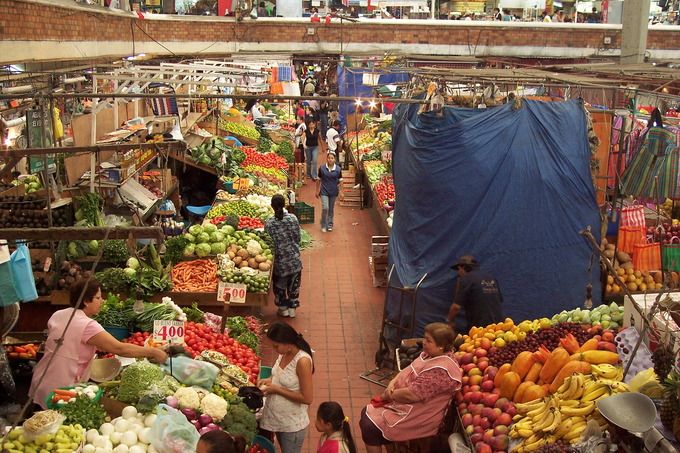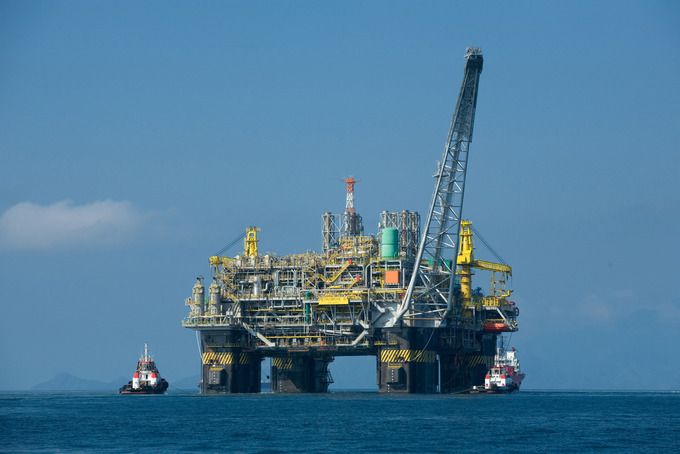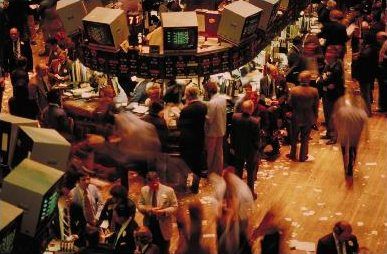14.4: Capital and Natural Resource Markets
- Last updated
- Save as PDF
- Page ID
- 3522

- Boundless
- Boundless
Other Factors of Production
There are three factors of production that are required to produce economic output: land, labor, and capital.
learning objectives
- Discuss the role of capital and resources in production
Factors of production are the inputs to the production process. Finished goods are the output. Input determines the quantity of output; in other words, output depends upon input. Input is the starting point and output is the end point of a production process and such input-output relationship is called a production function. There are three basic, otherwise known as classical, factors of production:
- Land: which includes the site where goods are produced as well as all the minerals below and above the site;
- Labor: which includes all human effort used in production as well as the necessary technical and marketing expertise; and
- Capital: which are the human-made goods used in the production of other goods, such as machinery and buildings.
Land is sometime included with capital in certain situations, such as in service industries where land has little importance. All three of these are required in combination at a time to produce a commodity. In economics, production means creation or an addition of utility. Factors of production (or productive ‘inputs’ or ‘resources’) are any commodities or services used to produce goods or services.
Further Defining Capital
In accounting and other disciplines, the phrase “capital” can also refer to cash that have been invested in a business. The classical economists also employed the word “capital” in reference to money. Money, however, was not considered to be a factor of production in the sense of capital stock since it is not used to directly produce any good. The return to loaned money or to loaned stock was styled as interest while the return to the actual proprietor of capital stock (tools, etc.) is classified as profit.
It is important to note that the final output is the result of the combination of all of the inputs. Things like technological advancement and worker productivity are intricately tied to the productivity of the inputs; it is not enough to simply have the factors of production in one place without the knowledge and ability to convert them into the correct outputs.
The Importance of Factor Prices
The prices of different factors of production can help determine which products a country will produce.
learning objectives
- Explain how changes in resource prices affect production
Comparative advantage is the ability of one country or region to produce a particular good or service at a lower opportunity cost than another. This idea suggests that in the long-run, entities will specialize in what costs them less to produce. These entities will then trade the goods they produce for the items that it would be expensive for them to produce. As a result, the prices of different factors of production can help dictate which products a country will choose to produce.

Trade: Trade and comparative advantage are why factor prices are so important in determining what a country produces. Trade allows a country to produce only what is comparatively cheaper for them to manufacture because they can get everything else they need through trade.
This idea was expanded upon in the Heckscher-Ohlin Model (H-O model), which was designed to be used to predict patterns of international commerce. This model is premised on several assumptions. These assumptions are:
- All countries have identical production technology;
- Production output is assumed to exhibit constant returns to scale;
- The technologies used to produce the two commodities differ;
- Factor mobility within countries;
- Factor immobility between countries;
- Commodity prices are the same everywhere; and
- Perfect internal competition.
If these assumptions are held to be true, the HO-model suggests that the exports of a capital-abundant country will be from capital-intensive industries, and labor-abundant countries will import such goods, exporting labor intensive goods in return.
For example, a country where capital and land are abundant but labor is scarce will have comparative advantage in goods that require lots of capital and land, but little labor. If capital and land are abundant, their prices will be low. As capital and land the main factors used in the production of grain, the price of grain will also be low, and thus attractive for both local consumption and export. Labor intensive goods on the other hand will be very expensive to produce since labor is scarce and its price is high. Therefore, the country is better off importing those goods.
Shifts in Factor Prices
Assuming the cost of relative goods remain constant, if one factor of production becomes more or less expensive, it can cause a significant shift of what is produced in that country.
If one factor of production becomes more plentiful, and therefore cheaper, it will cause production of the good that relies on that factor to increase. In response to that increase, the country will produce fewer goods that rely on other factors.
For example, imagine a country has a population boom from immigration. Its supply of labor will increase. As a result, the price of labor decreases. This country produces one good that is labor intensive, clothes, and one that is capital intensive, cars. When the cost of labor decreases, the country will produce more clothes and less cars. This is not necessarily a one-to-one relationship where the production of one more shirt means one less car is produced; the only thing that can be predicted is an overall shift in production levels.
It is important to note that the shifts in factor prices described above are based entirely on the assumptions found in the H-O Model. It is rare that a real market would meet all of those standards, so the results in the real world might vary from what this section describes.
Marginal Productivity and Resource Demand
Firms will demand more of a resource if the marginal product of the resource is greater than the marginal cost.
learning objectives
- Explain the relationship between marginal productivity and resource demand
The marginal product of a given resource is the additional revenue generated by employing one more unit of the resource. In the case of labor, for example, the marginal product of labor is the additional value generated for the company by hiring one additional worker. A firm will continue to employ more of the resource until the marginal revenue equals the marginal cost to the firm. The same concept applies to all resources that can be used in production, whether its labor or wood or land.
Since firms will seek to use additional resources if the net marginal product is positive, they can affect the demand for the resources. For many resources, the increased demand has the same effects as if it were any other input: an increase in demand will lead to an increase in price.

Oil Rig: Oil is a natural resource that is traded in markets. When firms have positive net marginal productivity from using more oil, demand for oil will rise.
Some resources, though, are public goods and therefore are not regulated by normal market forces. Take, for example, a body of water that multiple firms all use. If each firm has a positive marginal productivity of using more water in their manufacturing process, they will use more water since it’s free (there is no, or limited, marginal cost). If each firm individually chooses to use more water, the lake will eventually be damaged. This is known as the tragedy of the commons.
Governments have an incentive to attempt to correct such market failures. There are often regulations on the use of public goods to prevent the tragedy of the common, and there may be regulations on private goods as well (e.g. companies are required to get permits to mine on land they own).
Marginal Productivity and Income Distribution
Demand for the type of workers that can provide positive marginal productivity over marginal cost will see an increase in their wages.
learning objectives
- Explain how the marginal productivity of different factors can affect income distribution
Firms will hire workers if the marginal productivity of the worker is greater than the marginal cost. That is, firms will hire someone if the employee can produce more value for the firm than s/he costs in wages or salary.
Not all labor, however, is equal in the firm’s eyes. The two broad categorizations of laborers is skilled (e.g. doctor) and unskilled (e.g. an assembly line worker). Firms will hire the type of workers that they need.

Scientists are Skilled Workers: Scientists are skilled workers. Firms, such as pharmaceutical companies, will hire more scientists if the marginal productivity is greater than the marginal cost. This will drive up demand for scientists, and therefore their wages.
Suppose there are many firms with positive net marginal productivity of skilled labor. They will each seek to hire more skilled workers, driving up demand for skilled workers. This will increase the wages of skilled workers, but not of unskilled workers. Skilled workers will be gain proportionally more wealth than unskilled workers. Taken in aggregate, the marginal productivity of one type of worker influences the income that they earn in comparison to other types of workers.
On a national scale, this can have massive implications. If a country has a number of workers with high marginal productivity proportional to marginal cost, firms will want to hire those workers. Those workers will see gains to their income, affecting overall income distribution.
It is important to remember, however, that countries will specialize in goods in which they have a comparative advantage. If a country has an absolutely advantage in both skilled and unskilled workers, but a comparative advantage in unskilled workers, the country will specialize in the good that is intensive in the use of unskilled labor. The increased returns will go to unskilled workers (they will see their wages increase), even though the country also has an absolute advantage in skilled labor.
Capital Market
A capital market is a financial exchange for the buying and selling of long-term debt and equity-backed securities.
learning objectives
- Define the capital market
A capital market is a financial exchange for the buying and selling of long-term debt and equity-backed securities. The purpose of these markets is to channel the funds of savers to entities that would put that capital to long-term productive use (i.e. borrowers).

NYSE: This is the floor of the New York Stock Exchange. The NYSE is one of the largest capital markets in the world.
Primary vs. Secondary Markets
A key division within the capital markets is between the primary markets and secondary markets. In primary markets, new stock or bond issues are sold to investors. The main entities seeking to raise long-term funds on the primary capital markets are governments (which may be municipal, local or national) and business enterprises (companies). Governments tend to issue only bonds, whereas companies often issue either equity or bonds. The main entities purchasing the bonds or stocks include pension funds, hedge funds, sovereign wealth funds, and, less commonly, individuals and investment banks trading on their own behalf.
In the secondary markets, existing securities are sold and bought among investors or traders, usually on an exchange, over-the-counter, or elsewhere. The existence of secondary markets increases the willingness of investors in primary markets, as they know they are likely to be able to swiftly cash out their investments if the need arises.
Money Market vs. Capital Market
Money markets and capital markets are closely related, but are different types of financial markets. The money markets are used for the raising of short term finance, sometimes for loans that are expected to be paid back as early as overnight. Funds borrowed from the money markets are typically used for general operating expenses, to cover brief periods of illiquidity.
Capital markets are used for the raising of long term finance, such as the purchase of shares, or for loans that are not expected to be fully paid back for at least a year. When a company borrows from the primary capital markets, often the purpose is to invest in additional physical capital goods, which will be used to help increase its income. It can take many months or years before the investment generates sufficient return to pay back its cost, and hence the finance is long term.
Regular Bank Lending is Not a Capital Market Transaction
Regular bank lending is not usually classed as a capital market transaction, even when loans are extended for a period longer than a year. A key difference is that with a regular bank loan, the lending doesn’t take the form of resalable security like a share or bond that can be traded on the markets. A second difference is that lending from banks and similar institutions is more heavily regulated than capital market lending. A third difference is that bank depositors and shareholders tend to be more risk averse than capital market investors.
Natural Resource Market
Commodity markets are exchanges that trade in primary rather than manufactured products.
learning objectives
- Define the natural resource market
Natural resources are a fundamental part of the production process, as these goods make up the basis of any manufactured product. Most natural resources that are used can be acquired through the open market or through private deals. Below are some methods of acquiring different natural resources for production.
Public Goods
Some natural resources that are components of the production process are not sold, but are public goods. Public goods, like air and riverways, are non-excludable and non-rivalrous. This means that anyone can use these goods without paying a fee, and if one person uses the good it does not limit the ability of another to use the good.
As time has progressed, people have learned that some means of use of public goods in production processes can degrade certain natural resources. For example, pollution is a result of production processes that can foul the public goods of air and waterways. To combat this, governments have begun to impose ecotaxes on producers that use processes that pollute or otherwise dilute public goods. While not a market, these taxes are essentially a fee charged to producers for using public natural resources and can make the production process more expensive.
Commodity Markets
Commodity markets are exchanges that trade in primary rather than manufactured products. Not all commodities are natural resources, and not all natural resources are commodities, but commodity markets remain an important source for many resources. There are two types of commodities:

Chicago Mercantile Exchange: The Chicago Mercantile Exchange, shown above, is one of the world’s largest commodity markets.
- Soft commodities are agricultural products such as wheat, coffee, cocoa and sugar;
- Hard commodities are mined, such as gold, rubber and oil.
Commodity markets are heavily regulated. In the United States, the principal regulator of commodity and futures markets is the Commodity Futures Trading Commission (CFTC). The National Futures Association (NFA) formed in 1976 and is the futures industry’s self-regulatory organization. The NFA’s first regulatory operations began in 1982 and fall under the Commodity Exchange Act of the Commodity Futures Trading Commission Act.
In Europe, commodity markets are regulated by the European Securities and Markets Authority (Esma), based in Paris and formed in 2011. Esma sets position limits on commodity derivatives.
Closed Purchases
Not all natural resources can be acquired on commodity markets. Some must be acquired through direct purchases without the use of an intermediary clearing house. One example is for land. Land is one of the three factors of production, can be used to mine other natural resources and is absolutely necessary if a person wants to have a “brick and mortar” location where they can sell their goods. Land cannot be acquired through a commodity market, but must be obtained through an agreement with someone who owns the land. A person can either purchase the land outright or become a tenant of the person who owns the property.
The challenge of this process is that for these closed deals, the producer has to find the resource that they need, determine who owns it, and then negotiate with that person to obtain the resource. These costs can make these natural resources more expensive.
Key Points
- Land includes the site where goods are produced as well as all the minerals below and above the site.
- Labor includes all human effort used in production as well as the necessary technical and marketing expertise.
- Capital are the human-made goods used in the production of other goods, such as machinery and buildings. It does not include cash.
- The exports of a capital -abundant country will be from capital-intensive industries, and relatively labor -abundant countries will import such goods, exporting labor intensive goods in return.
- In the long-run, entities will specialize in what costs them comparatively less to produce.
- If one factor of production becomes more plentiful, and therefore cheaper, it will cause production of the good that relies on that factor to increase.
- When firms have positive net marginal products of resources, the demand for the resource will increase.
- Some resources are subject to the typical market constraints of supply and demand.
- Some resources are public goods, which means that they could be depleted if firms that have positive net marginal products from the resource are not regulated.
- Firms hire workers when they have higher marginal productivity than marginal cost.
- Workers are often categorized as either skilled or unskilled workers. Firms only hire the type of workers they need.
- If, on aggregate, there is a higher demand for skilled workers than unskilled workers, skilled workers will gain proportionally more income as their wages rise.
- In primary markets, new stock or bond issues are sold to investors, often via a mechanism known as underwriting. In the secondary markets, existing securities are sold and bought among investors or traders.
- The money markets are used for the raising of short term finance, sometimes for loans that are expected to be paid back as early as overnight. Capital markets are used for the raising of long term finance.
- Regular bank lending is not usually classed as a capital market transaction, even when loans are extended for a period longer than a year.
- There are two types of commodities. Hard commodities are mined and soft commodities are agricultural products.
- There are approximately 50 commodity markets worldwide. In general, these markets deal in purely financial transactions instead of outright purchases of goods. These financial transactions are known as financial derivatives.
- In the United States, the principal regulator of commodity and futures markets is the Commodity Futures Trading Commission (CFTC). The National Futures Association (NFA) formed in 1976 and is the futures industry’s self-regulatory organization.
Key terms
- capital: Already-produced durable goods available for use as a factor of production, such as steam shovels (equipment) and office buildings (structures).
- comparative advantage: The ability of a party to produce a particular good or service at a lower margin and opportunity cost over another.
- marginal productivity: The extra output that can be produced by using one more unit of the input
- capital market: The market for long-term securities, including the stock market and the bond market.
- commodity: Raw materials, agricultural and other primary products as objects of large-scale trading in specialized exchanges.
LICENSES AND ATTRIBUTIONS
CC LICENSED CONTENT, SPECIFIC ATTRIBUTION
- Factors of production. Provided by: Wikipedia. Located at: en.Wikipedia.org/wiki/Factors...on%23Classical. License: CC BY-SA: Attribution-ShareAlike
- capital. Provided by: Wiktionary. Located at: en.wiktionary.org/wiki/capital. License: CC BY-SA: Attribution-ShareAlike
- Rybczynski theorem. Provided by: Wikipedia. Located at: en.Wikipedia.org/wiki/Rybczynski_theorem. License: CC BY-SA: Attribution-ShareAlike
- Heckscher-Ohlin model. Provided by: Wikipedia. Located at: en.Wikipedia.org/wiki/Hecksch...3Ohlin_theorem. License: CC BY-SA: Attribution-ShareAlike
- Comparative advantage. Provided by: Wikipedia. Located at: en.Wikipedia.org/wiki/Comparative_advantage. License: CC BY-SA: Attribution-ShareAlike
- Boundless. Provided by: Boundless Learning. Located at: www.boundless.com//business/d...tive-advantage. License: CC BY-SA: Attribution-ShareAlike
- MercadodeSanJuandeDios. Provided by: Wikipedia. Located at: en.Wikipedia.org/wiki/File:Me...JuandeDios.jpg. License: CC BY-SA: Attribution-ShareAlike
- Heckscheru2013Ohlin model. Provided by: Wikipedia. Located at: en.Wikipedia.org/wiki/Hecksch...%23Conclusions. License: CC BY-SA: Attribution-ShareAlike
- Dutch disease. Provided by: Wikipedia. Located at: en.Wikipedia.org/wiki/Dutch_disease. License: CC BY-SA: Attribution-ShareAlike
- Public good. Provided by: Wikipedia. Located at: en.Wikipedia.org/wiki/Public_good. License: CC BY-SA: Attribution-ShareAlike
- Marginal productivity theory. Provided by: Wikipedia. Located at: en.Wikipedia.org/wiki/Margina...ctivity_theory. License: CC BY-SA: Attribution-ShareAlike
- Tragedy of the commons. Provided by: Wikipedia. Located at: en.Wikipedia.org/wiki/Tragedy_of_the_commons. License: CC BY-SA: Attribution-ShareAlike
- marginal productivity. Provided by: Wikipedia. Located at: en.Wikipedia.org/wiki/marginal%20productivity. License: CC BY-SA: Attribution-ShareAlike
- MercadodeSanJuandeDios. Provided by: Wikipedia. Located at: en.Wikipedia.org/wiki/File:Me...JuandeDios.jpg. License: CC BY-SA: Attribution-ShareAlike
- Oil platform P-51 (Brazil). Provided by: Wikipedia. Located at: en.Wikipedia.org/wiki/File:Oi...1_(Brazil).jpg. License: CC BY: Attribution
- Heckscher-Ohlin model. Provided by: Wikipedia. Located at: en.Wikipedia.org/wiki/Hecksch...%23Conclusions. License: CC BY-SA: Attribution-ShareAlike
- Marginal product of labour. Provided by: Wikipedia. Located at: en.Wikipedia.org/wiki/Margina...Marginal_costs. License: CC BY-SA: Attribution-ShareAlike
- NAFTA. Provided by: Wikipedia. Located at: en.Wikipedia.org/wiki/NAFTA. License: CC BY-SA: Attribution-ShareAlike
- Comparative advantage. Provided by: Wikipedia. Located at: en.Wikipedia.org/wiki/Comparative_advantage. License: CC BY-SA: Attribution-ShareAlike
- Marginal product of labor. Provided by: Wikipedia. Located at: en.Wikipedia.org/wiki/Margina...oduct_of_labor. License: CC BY-SA: Attribution-ShareAlike
- Unskilled labor. Provided by: Wikipedia. Located at: en.Wikipedia.org/wiki/Unskilled_labor. License: CC BY-SA: Attribution-ShareAlike
- Comparative advantage. Provided by: Wikipedia. Located at: en.Wikipedia.org/wiki/Comparative_advantage. License: CC BY-SA: Attribution-ShareAlike
- marginal productivity. Provided by: Wikipedia. Located at: en.Wikipedia.org/wiki/marginal%20productivity. License: CC BY-SA: Attribution-ShareAlike
- MercadodeSanJuandeDios. Provided by: Wikipedia. Located at: en.Wikipedia.org/wiki/File:Me...JuandeDios.jpg. License: CC BY-SA: Attribution-ShareAlike
- Oil platform P-51 (Brazil). Provided by: Wikipedia. Located at: en.Wikipedia.org/wiki/File:Oi...1_(Brazil).jpg. License: CC BY: Attribution
- Scientist looking thorugh microscope. Provided by: Wikimedia. Located at: commons.wikimedia.org/wiki/Fi...microscope.jpg. License: CC BY: Attribution
- Capital market. Provided by: Wikipedia. Located at: en.Wikipedia.org/wiki/Capital_market. License: CC BY-SA: Attribution-ShareAlike
- capital market. Provided by: Wiktionary. Located at: en.wiktionary.org/wiki/capital_market. License: CC BY-SA: Attribution-ShareAlike
- MercadodeSanJuandeDios. Provided by: Wikipedia. Located at: en.Wikipedia.org/wiki/File:Me...JuandeDios.jpg. License: CC BY-SA: Attribution-ShareAlike
- Oil platform P-51 (Brazil). Provided by: Wikipedia. Located at: en.Wikipedia.org/wiki/File:Oi...1_(Brazil).jpg. License: CC BY: Attribution
- Scientist looking thorugh microscope. Provided by: Wikimedia. Located at: commons.wikimedia.org/wiki/Fi...microscope.jpg. License: CC BY: Attribution
- NYSE-floor. Provided by: Wikipedia. Located at: en.Wikipedia.org/wiki/File:NYSE-floor.jpg. License: Public Domain: No Known Copyright
- Commodities exchange. Provided by: Wikipedia. Located at: en.Wikipedia.org/wiki/Commodities_exchange. License: CC BY-SA: Attribution-ShareAlike
- Commodity market. Provided by: Wikipedia. Located at: en.Wikipedia.org/wiki/Commodity_market. License: CC BY-SA: Attribution-ShareAlike
- Commodity market. Provided by: Wikipedia. Located at: en.Wikipedia.org/wiki/Commodi...ities_exchange. License: CC BY-SA: Attribution-ShareAlike
- Commodity market. Provided by: Wikipedia. Located at: en.Wikipedia.org/wiki/Commodi...s_and_policies. License: CC BY-SA: Attribution-ShareAlike
- Futures contracts. Provided by: Wikipedia. Located at: en.Wikipedia.org/wiki/Futures_contracts. License: CC BY-SA: Attribution-ShareAlike
- Commodity market. Provided by: Wikipedia. Located at: en.Wikipedia.org/wiki/Commodi...modity_Classes. License: CC BY-SA: Attribution-ShareAlike
- Forward contract. Provided by: Wikipedia. Located at: en.Wikipedia.org/wiki/Forward_contract. License: CC BY-SA: Attribution-ShareAlike
- Swap (finance). Provided by: Wikipedia. Located at: en.Wikipedia.org/wiki/Swap_(finance). License: CC BY-SA: Attribution-ShareAlike
- Green tax. Provided by: Wikipedia. Located at: en.Wikipedia.org/wiki/Green_t...Taxes_affected. License: CC BY-SA: Attribution-ShareAlike
- Land rights. Provided by: Wikipedia. Located at: en.Wikipedia.org/wiki/Land_rights. License: CC BY-SA: Attribution-ShareAlike
- Public goods. Provided by: Wikipedia. Located at: en.Wikipedia.org/wiki/Public_goods. License: CC BY-SA: Attribution-ShareAlike
- commodity. Provided by: Wiktionary. Located at: en.wiktionary.org/wiki/commodity. License: CC BY-SA: Attribution-ShareAlike
- MercadodeSanJuandeDios. Provided by: Wikipedia. Located at: en.Wikipedia.org/wiki/File:MercadodeSanJuandeDios.jpg. License: CC BY-SA: Attribution-ShareAlike
- Oil platform P-51 (Brazil). Provided by: Wikipedia. Located at: en.Wikipedia.org/wiki/File:Oi...1_(Brazil).jpg. License: CC BY: Attribution
- Scientist looking thorugh microscope. Provided by: Wikimedia. Located at: commons.wikimedia.org/wiki/Fi...microscope.jpg. License: CC BY: Attribution
- NYSE-floor. Provided by: Wikipedia. Located at: en.Wikipedia.org/wiki/File:NYSE-floor.jpg. License: Public Domain: No Known Copyright
- Cme building aerial view. Provided by: Wikipedia. Located at: en.Wikipedia.org/wiki/File:Cm...erial_view.jpg. License: CC BY-SA: Attribution-ShareAlike

